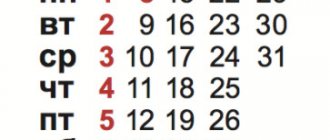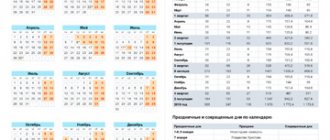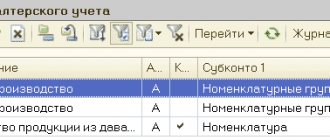general information
Information on working hours is contained in Article 91 of the Labor Code of the Russian Federation.
This period refers to the period of time when a person performs labor functions. By law, the standard duration of this time is 40 hours per week. In practice, such working hours are rarely used. Firstly, in many enterprises the production process cannot be stopped, so the work schedule there is shifting. Secondly, some categories of employees cannot work for such an amount of time, since by law they are entitled to a reduction in labor standards. These are minors, people with disabilities, etc.
However, the rules for calculating working hours stipulate that a 40-hour working week should be taken as a basis.
REMUNERATION WITH SUMMARY ACCOUNTING
There are some peculiarities in calculating salaries for employees who have summarized accounting. As a rule, if the organization as a whole or for certain categories of employees has introduced summarized recording of working hours, it means that working conditions deviate from normal. This could be systematic work on weekends and holidays, night work, overtime work, etc. Typically, such workers are given fairly high wage rates to compensate for extreme working conditions. However, a large salary does not relieve the employer of the obligation to pay for work in conditions deviating from normal, in accordance with the requirements of the Labor Code[1].
The specific amounts of remuneration in these cases, as well as the basic salary system, are established by collective agreements, other local regulations of organizations and directly by employment contracts. This is stated in Article 135 of the Labor Code of the Russian Federation.
Overtime work
Overtime work for cumulative accounting is considered to be work in excess of the normal number of working hours for the accounting period. At the same time, overtime work should not exceed four hours for each employee for two consecutive days and 120 hours per year. This is stated in Article 99 of the Labor Code of the Russian Federation.
The rules for paying overtime work are established in Article 152 of the Labor Code of the Russian Federation. For the first two hours it is paid no less than one and a half times the rate, and for subsequent hours - no less than double. Specific amounts of payment for overtime work may be determined by a collective or labor agreement, as well as local regulations. An employee may refuse increased pay and use additional rest time, but no less than overtime worked.
It is not difficult to determine the number of hours worked overtime when recording working hours together. Since within the accounting period the number of working hours should not exceed the norm, then all time exceeding the norm is considered overtime work. Difficulties begin when you need to calculate the amount of payment for overtime work.
If you follow the letter of the law, the first two hours of all hours worked overtime are paid at time and a half, and all other hours are paid at double time. Moreover, it does not matter when these hours were actually worked: on one day or throughout the entire accounting period.
This calculation method follows from the Labor Code, but does not reflect real working conditions. If a long accounting period is established (for example, a year), by the end of it the employee may have accumulated a large number of overtime hours.
There is another approach to paying overtime. The amount of overtime that does not exceed an average of two hours for each working day in the accounting period is paid at time and a half, and the remaining hours are paid at double rate. This approach is more logical, since it is impossible to establish the number of overtime hours in relation to specific working days (according to the rules of summarized accounting of working hours, overtime on one day can be compensated by underwork on another day). However, the provisions of Article 152 of the Labor Code of the Russian Federation do not allow us to confirm its legality.
| IF THERE WAS A DEFECT IN THE ACCOUNTING PERIOD Shortage (when an employee worked less than the normal number of working hours in an accounting period) can arise for two reasons: through the fault of the employee himself and through the fault of the employer. If failure to comply with labor standards or failure to fulfill labor (official) duties is a consequence of the employer’s fault, payment is made in an amount not lower than the average salary of the employee, calculated in proportion to the time actually worked (Article 155 of the Labor Code of the Russian Federation). This means that if during the accounting period an employee was unable to work the normal amount of working time due to the fault of the employer, then his salary will be calculated based on the normal amount of working time. How is the employee who is guilty of underperformance paid? If the reason is valid (vacation, illness, etc.), average earnings are usually paid for the period of absence from work. If the reasons are not valid (for example, absenteeism), no payment is made. |
What should an accountant do if his organization has established a summarized recording of working hours and the accounting period exceeds a month? We offer the following methodology, which does not contradict the law and reflects the specifics of the work.
When calculating wages each month, you need to take into account the number of hours actually worked by employees for that month. Each hour of work is paid in a single amount. When the results of the accounting period are summed up and the number of hours of overtime work is revealed, for the first two such hours it will be necessary to charge half the hourly tariff rate, and for all the rest - one tariff rate. In other words, you need to use coefficients of 0.5 and 1.0. They reflect the fact that all hours actually worked in the accounting period have already been paid in a single amount.
EXAMPLE 1. An employee of the organization OJSC Polet R.A. Smirnov has established a summarized recording of working time. The accounting period is quarter. Hourly tariff rate R.A. Smirnova - 200 rub./hour.
The normal number of working hours with a 40-hour work week in the first quarter of 2007 is 454. Due to the fact that it was necessary to replace an ill employee, R.A. Smirnov worked 641 hours in the first quarter of 2007, of which:
— in January — 198 hours (the norm is 136 hours);
— in February — 231 hours (the norm is 151 hours);
— in March — 212 hours (the norm is 167 hours).
Let us determine what payment R.A. should receive. Smirnov for overtime work.
SOLUTION. Let's determine how many hours worked in excess of the normal number of working hours during the accounting period:
641 hours – 454 hours = 187 hours.
Since in each of the months of the accounting period R.A. Smirnov received a salary in accordance with the number of hours actually worked; overtime hours were paid at a lower rate. So, for the first two hours of overtime work the payment will be equal to:
200 rub./hour x 0.5 x 2 hours = 200 rub.
All other hours of overtime work - 185 hours (187 hours - 2 hours) must be paid in a single amount. The payment amount will be:
200 rub./h x 1.0 x 185 h = 37,000 rub.
Thus, along with the salary for March 2007, the employee will receive payment for overtime work during the first quarter of 2007 in the amount of:
200 rub. + 37,000 rub. = 37,200 rub.
The salary for March is calculated based on the hours actually worked for this month (212 hours), and not on their normal number (167 hours). It is equal to: 200 rubles/hour x 212 hours = 42,400 rubles.
When determining the number of overtime hours for the accounting period, accountants must take into account the explanations of the USSR State Committee for Labor and the Presidium of the All-Union Central Council of Trade Unions dated 08.08.66 No. 13/P-21 “On compensation for work on holidays.” According to this document, when calculating overtime hours, work on holidays performed in excess of normal working hours is not taken into account, since it is already paid at an increased rate.
Here accountants will again use coefficients of 0.5 and 1.0.
EXAMPLE 2. Employee of Chaika JSC V.I. Mishin has been given a summary record of working time. The accounting period is a month. The employee's salary is 18,000 rubles.
According to the production calendar, the normal number of working hours with a 40-hour work week for February 2007 was 151. In February 2007, the employee actually worked 161 hours, including 8 hours outside the schedule on February 23.
The collective agreement provides for additional wages on weekends and non-working holidays at double the rate, as well as overtime pay for the first two hours of work at one and a half times the rate, and for the rest at double rate.
SOLUTION. Let's determine the average hourly earnings. It is equal to:
RUB 18,000.00 : 151 hours = 119.21 rubles/hour.
Let's calculate wages for February 2007 based on hours actually worked. It is equal to:
119.21 rub./hour x 161 hours = 19,192.81 rub.
The additional payment for working on a holiday will be:
RUR 119.21 x 8 hours x 1.0 = 953.68 rub.
The coefficient of 1.0 takes into account double payment on holidays (single payment is already taken into account when calculating the employee’s salary).
Let's calculate the number of hours worked overtime. This amount is determined minus the number of hours worked on a holiday outside the shift schedule. The number of hours of overtime work was:
161 hours - 151 hours - 8 hours = 2 hours.
The first two hours of overtime work are paid at time and a half. The payment amount is:
RUB 119.21 x 0.5 x 2 hours = 119.21 rub.
The coefficient of 0.5 takes into account time and a half payment for overtime hours (single payment is taken into account when calculating the employee’s salary for actual working hours).
Salaries for February 2007 will be:
RUB 19,192.81 + 953.68 rub. + 119.21 rub. = 20,265.70 rub.
Now let’s consider a situation where an employee worked on a holiday according to the shift schedule and within the normal working hours.
EXAMPLE 3. Let's change the conditions of example 2. A holiday (8 hours) was worked according to schedule. There was no overtime. The collective agreement of the organization provides for wages on holidays at double the rate, as well as for the first two overtime hours at one and a half times the rate and other overtime hours at double rate.
SOLUTION. Due to the fact that the employee has worked all the working hours, he will receive a full salary, which is 18,000 rubles. In order to calculate payment for work on a holiday, we determine the average hourly earnings. It is equal to:
RUB 18,000.00 : 151 hours = 119.21 rubles/hour.
The additional payment for working on a holiday will be:
119.21 rub./hour x 8 hours x 1.0 = 953.68 rub.
Salaries for February 2007 will be:
RUB 18,000.00 + 953.68 rub. = 18,953.68 rub.
Calculation for a month
Determining labor standards allows employers to correctly set work schedules, keep records of hours worked, pay wages and distribute vacations. Knowing how to correctly calculate the standard working time, you can easily determine how many hours an employee must work. One calendar month is often taken as the billing period.
Working hours are calculated as follows:
- First you need to find out how many working days there are in the selected accounting period, and how many weekends, holidays, etc.
- Next, the number of working hours per day is calculated. At the same time, do not forget that the normal length of a working week is 40 hours. This means you calculate the number of hours per working day. Example: 40/5=8.
- The number of days in a month when a subordinate works must be multiplied by 8 hours.
An example of such a calculation could be as follows:
- Let's say there are 21 working days in June.
- The authorized employee must determine the standards by which the personnel will work.
- For this, the time standard will be calculated using the following formula: 21*8=168 hours. This is exactly how much each subordinate must work on average.
To correctly calculate working hours, you need to check the production calendar. It contains all the information about the number of work shifts for each calendar month.
Calculation of summarized working time recording
This calculation is used in cases where it is not possible to maintain the normal working week. For example, employees work in shifts. With such a work schedule, it is necessary to use not only a different accounting of working hours, but also calculate wages differently.
Under normal working conditions, the working week should not exceed 40 working hours per week. That is, it is 5 days a week for 8 hours. But some employers apply a different work schedule when the daily shift extends beyond the 8-hour workday. As a rule, such a schedule is used in organizations that provide services to citizens or trade. For example, medical institutions, convenience stores, pharmacies, transport, etc.
To comply with the law and increase labor efficiency, the employer introduces shift work schedules. To avoid violations, it is necessary that the duration of work duties during the accounting period is no more than a normal week, multiplied by the number of weeks in the accepted accounting period. The maximum length of the accounting period is generally 1 year, according to Art. 104 Labor Code of the Russian Federation.
Quarterly calculation
It is also important to know how to calculate the standard working hours for a quarter, that is, for three months. The standard working day is 8 hours. All calculations are carried out very simply. First you need to determine what the labor norm is in each month.
Calculation example:
- Let's assume that there are 168 work hours in July. It remains to calculate the amount of time only for the next 2 months.
- There are also 168 working hours in August, and 160 in September.
- This means that the norm for the quarter is as follows: 168+160+168=496 hours.
If necessary, a similar calculation can be carried out for each quarter. Most often, company management uses the definition of the norm on a quarterly basis.
Calculation for a year
Labor rationing is an important procedure that allows you to determine the number of hours that employees are required to work. When making calculations, the calendar year is often used as the accounting period. Hours are calculated in two ways. You can use the method that is used to calculate the quarter. You just need to determine the amount of the working period for all 12 months.
Another procedure for determining the norm was established by order of the Ministry of Health and Social Development of the Russian Federation No. 588n. The calculation is carried out using the formula: 40/5*number of working days per year. After this, from the resulting number you should subtract the number of hours that the employees did not work. We are talking about reductions before the holidays.
When determining the norm for 2021 according to the billing period, the following nuances should be taken into account:
- Sunday must be counted as a day off. And it doesn’t matter how many days of rest a subordinate actually has per week - 2 or 1. For some categories of subordinates, it is possible to transfer the day of rest to another date.
- Don't forget about official holidays, which are not used in calculations.
- When a holiday falls on a day of rest, the day off is postponed. These rules do not need to be used only when calculating labor standards for January.
- The length of the working day before a holiday is always reduced by 1 hour.
When making calculations, you must follow these rules, otherwise the final number of hours will be incorrect.
The procedure for calculating vacation pay
Based on the Labor Code of the Russian Federation, the employer is obliged to pay the employee not only working hours, but also the period of annual leave.
The amount of vacation pay is calculated for each calendar day during which the employee was on vacation, taking into account the amount of average daily earnings:
Vacation pay = AvgDnZ * KolDn,
where Average daily earnings determined for the billing period; KolDn – vacation period by order (in calendar days).
The calculation period for determining the amount of vacation pay is 12 months preceding the month of vacation. For example, for an employee who goes on vacation from September 20, 2021, the billing period will be September 1, 2017 – August 31, 2021.
Types of charts
The length of the working day most often depends on production needs. Therefore, it is rare that employers can provide their staff with a standard 5-day period. The most commonly used modes are:
- 24 hour shift with several days off.
- Work shift with 10 or 12 hours of work. Then the staff has more days off than planned.
- Shift is 12 hours, with alternating day and night shifts.
Note: these are not all the regimes that able-bodied citizens have to face. But, based on the specifics of some professions, a regular 8-hour shift may be disadvantageous for both management and the subordinates themselves.
https://www.youtube.com/watch?v=YtMOJEFrytA
Production calendar
In order for managers to correctly calculate labor standards, there is a special document. This is the so-called production calendar, which takes into account all working days, as well as rest days, including holidays. This document is not a normative act and therefore has no legal force.
However, it is very useful for accountants or HR employees whose responsibilities include keeping time records and calculating earnings. The production calendar can be found online and used at your discretion. Also, the law does not prohibit organizations from independently developing such documents. To do this, you can take a regular calendar and indicate working days and weekends in it in accordance with established rules.








